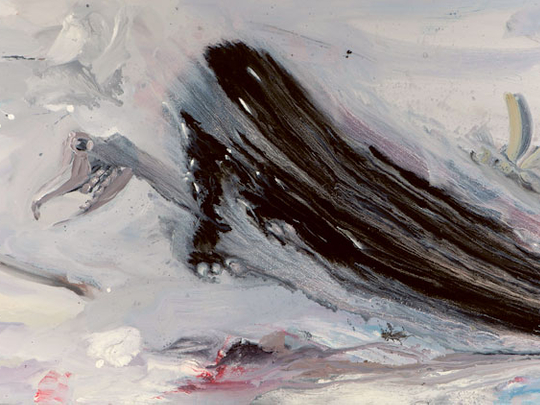
Farzan Sadjadi decided to get away from his familiar surroundings in Tehran and go to the remote village of Mar, because as an artist he wanted to free his mind and create something different. The nine months he spent in this isolated, forgotten place in central Iran had a deep impact on him, which can be seen in his latest work, titled “Wet Dog”. His intense paintings capture the harshness of the environment and the hard life of the people. Through the daily struggles of these simple folk, the artist conveys his own inner struggles and sense of isolation, and also comments on the socio-political situation in his country and the world.
“I had an exhibition coming up and went to Mar because I thought I would get the mental and physical space to allow my creativity to flow and to make large paintings outdoors. Living there was not easy, because it is windy all the time, there were strong blizzards in winter and there is always scarcity of water. The extreme climate and the difficult living conditions in the area have forced most of the inhabitants of this village to move out, leaving behind just a few elderly people, who eke out a living by farming and herding goat. But for me, it was an amazing experience to live without the basic comforts we are used to in the city. I was cut off from the rest of the world and gradually found myself getting involved with the people there. I went to Mar because I wanted to go deep within myself to do some conceptual paintings about mythical creatures. But I just could not help making paintings of the reality I saw around me,” Sadjadi says.
His paintings depict the everyday life in the village, such as people toiling in their farms and herding their goats. But the images are full of drama and emotion. His grey palette and the titles reflect the hardship endured by the people and the animals. For instance, one painting of what looks like a typical gathering of villagers is titled “Daily Quarrel”. “Every morning I could hear the sounds of the people arguing over whose turn it was to draw water from the mountain spring, which was the only source of water,” he says. Similarly, a painting of goats on the mountainside is titled “Between the Thorns”. “The place was so dry that the goats really had to search for a few clumps of greenery,” he says.
In another painting of goats, an uprooted tree in the background symbolises death and destruction. But Sadjadi has called this painting “Vegan”. “The animals are so cute, and I became so attached to them that it became difficult for me to eat meat,” he explains with a smile.
Another animal that he got attached to was a stray dog. But the dog’s death, caused by poisoning, moved him to make some very emotional paintings of the creature’s last moments. “This dog had been abandoned by its owner, but it was not accepted by the pack of wild dogs which roamed around in the area. Hence he was constantly getting into fights with them and was badly bruised. We became friends after I began offering him food. But he died after he was poisoned by the villagers to protect their herds from attack. I understood why the villagers had to do this, but it was terrible to watch him in the throes of death, in pain and desperate with thirst. In fact, this incident became the trigger that pushed me to start painting again after months of inactivity,” Sadjadi says.
He began to find inspiration in the ordinary people and events around him, such as the man who came to clear the snow from his rooftop after a blizzard, and the nearly blind shepherd who lost most of his herd because he thought he saw a wolf and panicked. “When life is routine, even mundane events become significant,” he says.
An interesting feature of Sadjadi’s paintings is that he uses ordinary house paint on canvas and often paints the same subject in many different ways. He has done three versions of the man clearing the snow to create a triptych. While one painting captures the man’s attitude, another focuses on his movements and the brightness of the snow against the clear blue sky. The third is an abstract deconstruction in a different palette of colours. “I like house paint because it dries quickly. And I love to explore a subject from various angles and in various styles. I could do ten more paintings of this subject,” he says.
Sadjadi’s paintings are simple and straightforward. But beneath the surface of these ordinary rural scenes are allegorical references to social and political issues. “Once upon a time, all the land in this village belonged to my family. After the revolution, the farmers who tilled the land became the owners. While the villagers live a hard life, my family looks at this place as a holiday spot. Living among these people made me reflect on our changing relationship with them, about the socio-political situation in my country, and about life itself. This was the first time I moved away from my normal environment to work. And I want to continue working on this subject from the distance and comfort of my home,” he says.
Jyoti Kalsi is an arts enthusiast based in Dubai.
Wet Dog will run at Carbon 12 gallery until September 10. The gallery will be closed from August 1 to August 21.











